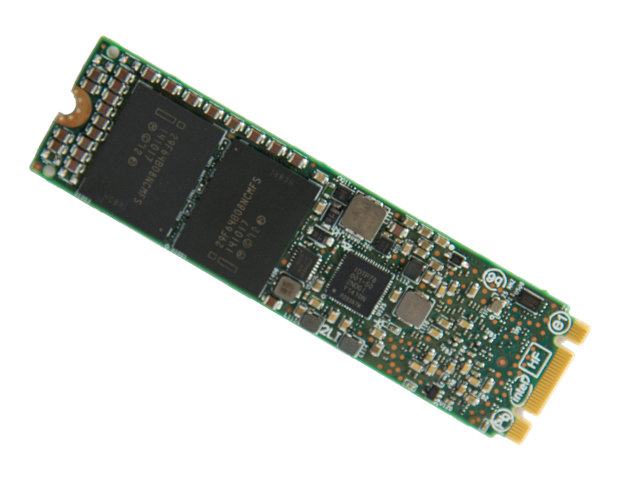Intel Launches M.2 and Larger Capacity 2.5" SSD DC S3500 Models
by Kristian Vättö on November 11, 2014 12:33 PM EST- Posted in
- Storage
- SSDs
- Intel
- Enterprise
- Enterprise SSDs

Two years ago Intel released the DC S3500 and S3700 SSDs that marked as the company's first truly in-house SATA 6Gbps SSDs. Today Intel is adding M.2 form factor to the S3500 lineup along with higher capacity options in the regular 2.5" size.
The original S3500 came in capacities ranging from as small as 80GB to up to 800GB, but with the increasing demand for high density storage, Intel is adding 1.2TB and 1.6TB offerings. There is no change in the Flash Translation Layer (FTL) design to accommadate the extra NAND nor are there any other firmware or hardware changes, so the new models simply have more NAND on the board.
The 1.2TB and 1.6TB models provide higher randon write speeds, which makes sense given the additional NAND. Typically steady-state random write performance increases with more NAND thanks to increased parallelism, although only to a certain threshold since more NAND also adds tracking overhead. In the case of the S3500, the 1.2TB model appears to be the sweetspot by offering 18.5K random write IOPS, whereas the 1.6TB SKU drops that figure to 14.6K IOPS. Moreover, write endurance scales nearly linearly with the capacity as the 1.2TB is rated at 660TB and the 1.6TB at 880TB, while the existing 600GB and 800GB models are rated at 330TB and 450TB respectively.
The M.2 version of the S3500 is one of the first enterprise-class SSDs in M.2 form factor. Feature wise the M.2 models are equal to their 2.5" counterparts, meaning that there is full power-loss protection, end-to-end data protection and AES-256 encryption. The M.2 models come in M.2 2280 form factor and due to the space constraints, only 80GB, 120GB and 340GB capacities are available.
The M.2 models actually carry slightly higher random write speeds compared to their 2.5" counterparts, although that comes at the slight expense of random read performance. Since there is no metal chassis to help with heat dissipation, the M.2 models are a bit more exposed to thermal throttling, although Intel assured that as long as there is enough airflow in the system the drive should stay within its operating temperatures and not throttle itself.
At this stage M.2 hasn't really been adopted by the enterprise space yet, but there is a growing interest for it due to the space savings. Intel told me that they are in talks with multiple OEMs about integrating the M.2 S3500 to servers, but as of now the main market for the S3500 is embedded devices. This includes devices like ATMs, slot machines and cash registers, which are transitioning to SSDs to save space and increase reliability. The S3500 is certainly a good fit for that segment with its enterprise-class feature set, whereas most M.2 drives on the market lack features like full power-loss protection.
While many consumer drives are selling at below $0.50/GB, the enterprise features and additional validation increase the cost of the S3500. At right below the $1 per GB mark, the S3500 is, however, a rather competitive drive in the entry-level enterprise segment.













10 Comments
View All Comments
Samus - Tuesday, November 11, 2014 - link
Is that 340GB or 240GB?If I remember correctly, the S3500 isn't really meant for mobile (lacks Devsleep?) and uses a lot of power, so it's interesting to see an M.2 version. Maybe for server motherboards or something?
They're also priced completely out of touch with consumers. The M550 with the SAME NAND DIE as the S3500 sells for $40 less with +180GB...
I love Intel SSD's though.
Kristian Vättö - Tuesday, November 11, 2014 - link
It's 340GB. As I mentioned in the article, the main market for the M.2 S3500 is embedded devices (like ATMs), which aren't usually portables. There is also growing interest for M.2 in the enterprise (for data center use as well as just a server boot drive). The cost is explained by enterprise features (like full power-loss protection) and validation.jwhannell - Tuesday, November 11, 2014 - link
I would really like my next i5 micro ATX build to have an intel m.2 for a boot drive, if possible. I just love the compactness of it all (even though it's totally unnecessary). I'm hoping in Feb/March that the pricing will be a bit more competitive. Regarding your "I Love Intel SSDs" - i think they have a great brand and name for reliability etc. so they are probably banking on that name to make up some of the difference in cost...which kind of sucks for us.MrCommunistGen - Tuesday, November 11, 2014 - link
If you look at any/all the M.2 sections of the charts (presumably provided by Intel based on color scheme, font, etc), they say 340GB.hfm - Tuesday, November 11, 2014 - link
Are there any M.2 SATA drives bigger than 512GB?mkozakewich - Tuesday, November 11, 2014 - link
Nice.I'm still waiting on good pocketable M.2-to-USB 3.0 enclosures so I can finally quit flash drives and just replace the enclosure when it ends up becoming damaged.
mkozakewich - Tuesday, November 11, 2014 - link
(I'm just taking another look around, and there are more than there were a few months ago. This looks promising: http://www.amazon.com/ZTC-Enclosure-Adapter-SuperS... )galfert - Tuesday, December 9, 2014 - link
The problem is that you will not have TRIM. I much prefer the Corsair GTX USB drive that has TRIM.JellyRoll - Tuesday, November 11, 2014 - link
The new versions of the DC S3500 actually have a new controller, as per reports from several other tech publications.Kristian Vättö - Wednesday, November 12, 2014 - link
That is not what I was told by Intel, but let me check with them again.